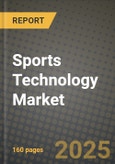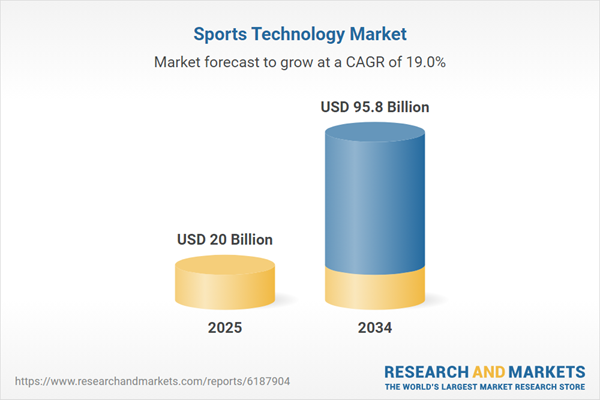The sports technology market represents a dynamic fusion of athletic performance, digital innovation, and fan engagement. It encompasses a wide range of solutions, including wearable sensors, performance analytics software, virtual and augmented reality, smart equipment, and stadium technologies. This sector has become a critical enabler of modern sports, offering athletes and coaches deeper insights into training regimens, recovery, and biomechanics, while also transforming how fans consume and interact with sports content. From grassroots development to elite competition, sports technology is helping optimize strategies, prevent injuries, and drive real-time decision-making. In parallel, tech is reshaping broadcasting, ticketing, merchandise, and venue management, allowing clubs and leagues to operate more efficiently and connect with fans on a more personal level. As digital transformation accelerates across industries, sports organizations are prioritizing innovation, creating fertile ground for startups and established tech firms alike to deploy disruptive solutions that redefine what it means to compete and spectate in the modern era.
The sports technology market saw significant momentum across multiple domains. Athlete monitoring systems evolved to capture granular biometric data - such as heart rate variability, hydration levels, and movement efficiency - feeding into AI-powered platforms that delivered tailored training feedback. Smart wearables integrated seamlessly with coaching apps, allowing real-time adjustments during training or matches. Stadiums adopted facial recognition for seamless entry, contactless concession ordering, and crowd management, enhancing both security and fan experience. Meanwhile, broadcast tech expanded with ultra-low latency streaming and interactive features such as multi-angle replays and live polling. AR overlays and holographic displays gained traction at sports bars and live venues, offering immersive experiences without the need for headsets. Esports and hybrid sports formats integrated blockchain and virtual marketplaces to deepen user participation through NFTs and tokenized loyalty programs. Startups continued to flourish, particularly in Europe, North America, and Southeast Asia, focusing on modular tech tools for youth development and amateur coaching platforms. As sports returned to full capacity and major events resumed, tech-enabled fan engagement, athlete performance, and operational efficiency became central to competitive success.
The sports technology market is expected to embrace even more intelligent, decentralized, and sustainable innovations. AI and machine learning will drive predictive performance analytics and injury prevention, with systems capable of forecasting fatigue, muscle strain, and stress levels before issues arise. Athlete data will be more securely managed via blockchain, granting players greater control over their biometric profiles and sharing permissions. The fan experience will evolve further, as VR broadcasts, digital twin stadiums, and AI-generated commentary become more common. Youth sports will see increased adoption of affordable, app-connected sensors and video tools that democratize access to elite-level coaching insights. Sustainability will take center stage, with smart energy systems and carbon-tracking platforms being integrated into sports infrastructure and event planning. As personalization becomes the norm, sports tech will support individual training journeys, immersive fan narratives, and more inclusive participation models. The market’s growth will continue to be defined by the ability to enhance performance, protect athlete welfare, and elevate fan connection in ways previously unimaginable.
Key Insights: Sports Technology Market
- AI-powered performance analytics tools are transforming how athletes train and recover, offering real-time adjustments and injury prevention through biometric monitoring and data modeling.
- Smart stadium solutions, including facial recognition and contactless services, are enhancing venue operations while improving fan safety and experience.
- AR and VR are gaining traction in both training and spectator experiences, creating immersive simulations and live visual enhancements without disrupting gameplay.
- Wearable technology is becoming more sophisticated, integrating with apps and coaching platforms to deliver real-time insights on movement, fatigue, and wellness.
- Blockchain technology is being explored for secure athlete data ownership, anti-doping compliance, and digital asset monetization like NFTs and token-based fan engagement.
- Rising demand for data-driven athlete development is encouraging widespread adoption of performance tech in both professional and amateur sports.
- Growing investment in sports infrastructure and event digitization is pushing the integration of smart systems across stadiums, training centers, and broadcast platforms.
- Increasing consumer appetite for immersive and personalized viewing experiences is driving innovation in AR, VR, and multi-device streaming tech.
- Expansion of esports and hybrid sports formats is creating demand for cross-platform technologies and integrated fan engagement ecosystems.
- Data privacy concerns around athlete biometrics and fan engagement platforms are prompting stricter regulations and raising questions about ownership, consent, and cybersecurity in sports tech ecosystems.
Sports Technology Market Segmentation
By Sports Type
- Baseball
- Basketball
- Cricket
- Ice Hockey
- Tennis
- Soccer
- Rugby
By Technology
- Device
- Smart Stadium
- Esports
- Sports Analytics
By End-User
- Sports Associations
- Clubs
- Leagues
- Athletes
- Coaches
Key Companies Analysed
- Apple Inc.
- ChyronHego Corporation
- Cisco Systems Inc.
- HCL Technologies Limited
- Infosys Limited
- Modern Times Group MTG
- Oracle
- Panasonic Corporation
- SAP SE
- Sony Corporation
- Stats LLC
- Telefonaktiebolaget LM Ericsson
- Agile Sports Technologies Inc.
- Athlete Intelligence
- Catapult Group International Ltd.
- Chetu Inc.
- Epicor Software Corporation
- Firstbeat Technologies Oy
- International Business Machines Corporation
- Jonas Club Software
- Genius Sports
- VICIS
- Stack Sports
- Playermaker
- Strava
- Nextiles
- Proteus
- ShotTracker
- Zebra Technologies
- Hawk-Eye Innovations
- Sportradar
- Kinexon
- KINEXON Sports & Media GmbH
- PlaySight Interactive
- Sparta Science
- MyVert
- Blast Motion
- CoachMePlus
- Krossover Intelligence
- Hudl
- Coach Logic
- SPT Sports
- Fusion Sport
- Kinduct Technologies
- Kitman Labs.
Sports Technology Market Analytics
The report employs rigorous tools, including Porter’s Five Forces, value chain mapping, and scenario-based modeling, to assess supply-demand dynamics. Cross-sector influences from parent, derived, and substitute markets are evaluated to identify risks and opportunities. Trade and pricing analytics provide an up-to-date view of international flows, including leading exporters, importers, and regional price trends.Macroeconomic indicators, policy frameworks such as carbon pricing and energy security strategies, and evolving consumer behavior are considered in forecasting scenarios. Recent deal flows, partnerships, and technology innovations are incorporated to assess their impact on future market performance.
Sports Technology Market Competitive Intelligence
The competitive landscape is mapped through proprietary frameworks, profiling leading companies with details on business models, product portfolios, financial performance, and strategic initiatives. Key developments such as mergers & acquisitions, technology collaborations, investment inflows, and regional expansions are analyzed for their competitive impact. The report also identifies emerging players and innovative startups contributing to market disruption.Regional insights highlight the most promising investment destinations, regulatory landscapes, and evolving partnerships across energy and industrial corridors.
Countries Covered
- North America - Sports Technology market data and outlook to 2034
- United States
- Canada
- Mexico
- Europe - Sports Technology market data and outlook to 2034
- Germany
- United Kingdom
- France
- Italy
- Spain
- BeNeLux
- Russia
- Sweden
- Asia-Pacific - Sports Technology market data and outlook to 2034
- China
- Japan
- India
- South Korea
- Australia
- Indonesia
- Malaysia
- Vietnam
- Middle East and Africa - Sports Technology market data and outlook to 2034
- Saudi Arabia
- South Africa
- Iran
- UAE
- Egypt
- South and Central America - Sports Technology market data and outlook to 2034
- Brazil
- Argentina
- Chile
- Peru
Research Methodology
This study combines primary inputs from industry experts across the Sports Technology value chain with secondary data from associations, government publications, trade databases, and company disclosures. Proprietary modeling techniques, including data triangulation, statistical correlation, and scenario planning, are applied to deliver reliable market sizing and forecasting.Key Questions Addressed
- What is the current and forecast market size of the Sports Technology industry at global, regional, and country levels?
- Which types, applications, and technologies present the highest growth potential?
- How are supply chains adapting to geopolitical and economic shocks?
- What role do policy frameworks, trade flows, and sustainability targets play in shaping demand?
- Who are the leading players, and how are their strategies evolving in the face of global uncertainty?
- Which regional “hotspots” and customer segments will outpace the market, and what go-to-market and partnership models best support entry and expansion?
- Where are the most investable opportunities - across technology roadmaps, sustainability-linked innovation, and M&A - and what is the best segment to invest over the next 3-5 years?
Your Key Takeaways from the Sports Technology Market Report
- Global Sports Technology market size and growth projections (CAGR), 2024-2034
- Impact of Russia-Ukraine, Israel-Palestine, and Hamas conflicts on Sports Technology trade, costs, and supply chains
- Sports Technology market size, share, and outlook across 5 regions and 27 countries, 2023-2034
- Sports Technology market size, CAGR, and market share of key products, applications, and end-user verticals, 2023-2034
- Short- and long-term Sports Technology market trends, drivers, restraints, and opportunities
- Porter’s Five Forces analysis, technological developments, and Sports Technology supply chain analysis
- Sports Technology trade analysis, Sports Technology market price analysis, and Sports Technology supply/demand dynamics
- Profiles of 5 leading companies - overview, key strategies, financials, and products
- Latest Sports Technology market news and developments
Additional Support
With the purchase of this report, you will receive:- An updated PDF report and an MS Excel data workbook containing all market tables and figures for easy analysis.
- 7-day post-sale analyst support for clarifications and in-scope supplementary data, ensuring the deliverable aligns precisely with your requirements.
- Complimentary report update to incorporate the latest available data and the impact of recent market developments.
This product will be delivered within 1-3 business days.
Table of Contents
Companies Mentioned
- Apple Inc.
- ChyronHego Corporation
- Cisco Systems Inc.
- HCL Technologies Limited
- Infosys Limited
- Modern Times Group MTG
- Oracle
- Panasonic Corporation
- SAP SE
- Sony Corporation
- Stats LLC
- Telefonaktiebolaget LM Ericsson
- Agile Sports Technologies Inc.
- Athlete Intelligence
- Catapult Group International Ltd.
- Chetu Inc.
- Epicor Software Corporation
- Firstbeat Technologies Oy
- International Business Machines Corporation
- Jonas Club Software
- Genius Sports
- VICIS
- Stack Sports
- Playermaker
- Strava
- Nextiles
- Proteus
- ShotTracker
- Zebra Technologies
- Hawk-Eye Innovations
- Sportradar
- Kinexon
- KINEXON Sports & Media GmbH
- PlaySight Interactive
- Sparta Science
- MyVert
- Blast Motion
- CoachMePlus
- Krossover Intelligence
- Hudl
- Coach Logic
- SPT Sports
- Fusion Sport
- Kinduct Technologies
- Kitman Labs .
Table Information
| Report Attribute | Details |
|---|---|
| No. of Pages | 160 |
| Published | October 2025 |
| Forecast Period | 2025 - 2034 |
| Estimated Market Value ( USD | $ 20 Billion |
| Forecasted Market Value ( USD | $ 95.8 Billion |
| Compound Annual Growth Rate | 19.0% |
| Regions Covered | Global |
| No. of Companies Mentioned | 45 |









